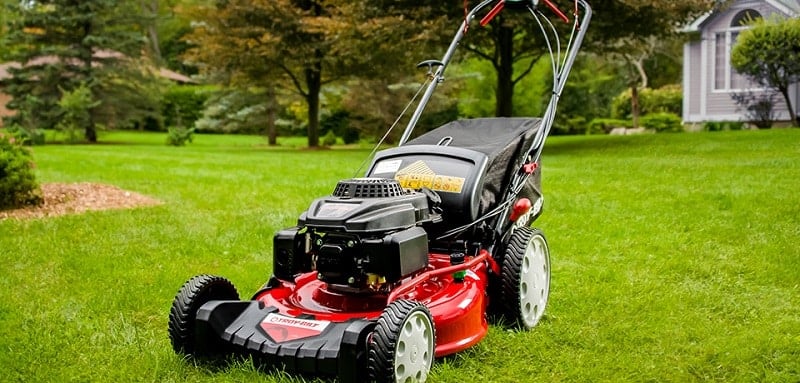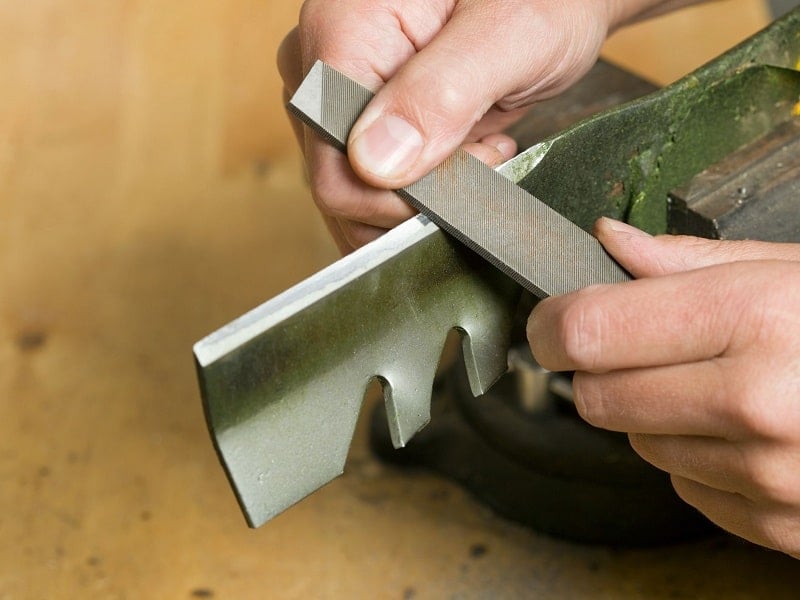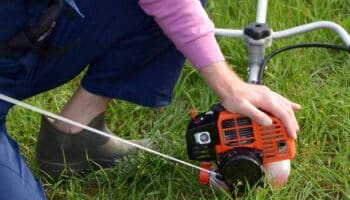We all want to keep up with the Joneses and if you live in the ‘burbs, that often means having a pristine lawn.
If you’re setting out to hold the attention of any suburbanite, then simply ask how they keep their yard so green and lush. You’ll likely be talked to for hours about the best fertilizers, weed removers, and the latest and greatest gardening tools. However, in order to keep your lawn in tip-top condition, there is no doubt that a lawnmower is central to the whole process.
Sharp lawn mower blades are a necessary component for a good-looking lawn and the secret to ensuring an even cut.
Nevertheless, over time your mower blades will inevitably dull, so we are here to help. Worn blades will create an uneven grass height, and torn grass edge tends to quickly discolour. You’ll end up the talk of the neighborhood, and not in a good way if you don’t sort this out!
Have a read through our simple guide to sharpening your lawnmower blades, without even needing to remove them from the machine. It’s a surprisingly easy task that you should add to your garden maintenance routine.
Setting Up
Before you start sharpening your mower blades, make sure that you have the following items on hand:
- A lawnmower (yep – let’s state the obvious)
- Gloves that are cut-proof
- Safety glasses
- An electric grinder or an approximately ten-inch metal file
- A de-burring rod
- A bucket of water, putty knife, and brush to get out any caked-on garden debris
Step By Step Guide
You will likely need to replace your mower blades every one to three years completely.
Sharpening mower blades is not a difficult task, and if you do this you’ll see a massive difference between how easy it is to cut your lawn and how clean of a cut your mower can get.
Here’s the step-by-step guide to sharpening lawn mower blades without removing them:
- If your lawnmower is electric, then make sure your mower isn’t plugged in
- If your lawnmower is gas, then make sure the key isn’t in (yep, we are making this dummy-proof)
- Disconnect the spark plug from the ignition wire, just to be on the safe side
- We recommend that you wear appropriate safety equipment including gardening gloves that are cut-resistant, safety goggles, and shoes (clothes, in general, should be worn, in case we need to point that out)
- To get to the mower blade, either tip the mower on its side, or open up the side grass shoot, depending on your model.
- If you tip the mower, make sure that the carburetor and gas filter is on the top side
- Ensure that the mower won’t fall over and smash onto your feet (trust us, it hurts)
- With a bucket of water, putty knife, and brush, get out as much caked-on garden debris and mud as possible
- You can use either a handheld, electric grinder with a metal disk or a metal file, whichever you have available and are more comfortable using
- Make sure you only work in one direction and only sharpen the top face of the blade. This means that instead of a back and forth sawing motion, you’ll be lifting the grinder or file each time
- Ideally, get to an angle of 45 degrees on the top edge
- Once you have done one side of the blade, rotate it and do the other side to the same degree. Since you won’t be taking the blade off of the mower, you can’t be sure that the blade is balanced so take care to ensure both sides are evenly sharpened
- Then do the underside edge to smooth off any rough bits with a de-burring rod and have a quick visual check to make sure all of the nuts are tight
- Now go and cut the grass!
Benefits of sharp lawnmower blades
Sharp lawn mower blades slice through grass quickly and with ease to leave a smooth, even top to your lawn. On the other hand, dull blades will rip your grass or simply refuse to pick them up, and the rough edge will not only look unkempt but tend to turn yellow or brown and are an invitation for disease and pests to take hold. The relatively simple procedure of keeping your mower blades sharp is worth the energy compared to weeks or months of getting your lawn back into shape if it has turned patchy and brown. This can also save you a lot of money on lawn care products. So, to recap:
Sharp mower blades lead to:
- Lawns that are easier and quicker to mow
- Lawns with a smoother, even top
- Lawns that are greener and lusher
- Lawns that are less prone to disease and pests
Lawn Mower Blade FAQ’s
How much does it cost to sharpen lawn mower blades?
If you want to get your lawnmower blades professionally sharpened, then this will likely set you back about $20 to $60. Not only will this put a potentially unnecessary dent in your wallet, but getting your mower blades to the shop can seriously cut into the time spent on more entertaining summer activities.
You’ll need to have the tools to take the blades off of your mower and clean them to a degree that shows that you didn’t last service your mower a decade ago. Drive to the shop, wait… wait… maybe come back later, and then drive home and put them all back on again. I don’t know about you, but I would rather spend that summer sunshine time doing just about anything else.
I’m thinking of sitting back with an ice-cold lager or two while swishing my feet in a blow-up paddle pool and sniffing the sweet smell of freshly cut grass. I have priorities!
How often should lawn mower blades be sharpened?
There are a few obvious factors that will determine how often you need to sharpen your mower blades.
First off, it depends on how often you cut your grass. In general, after cutting your grass for about twenty hours, your mower blade will need to be sharpened. Therefore, a more extensive lawn that might take an hour to cut will need the blades sharpened after about twenty uses. A smaller property that only takes a half-hour to cut will require the blades sharpened after forty uses. You can work out the math for the rest. The more often you mow your grass, the more often you’ll need to sharpen the blades.
The overall condition and age of your mower can also affect how often your blades need to be sharpened, as well as if the blades are balanced. Cleaning your lawn from garden debris, kids’ toys, rocks, and twigs can extend the lifespan of your mower blades.
Doing a sweep of your lawn before cutting isn’t only so that you don’t fling dog poop everywhere (though that is undoubtedly a good idea) but to make sure your mower blades don’t get needlessly dull from hitting rocks or tearing a kid’s plastic toy to shreds.
We do recommend that you sharpen your mower blades at the beginning of every season, and then you’ll likely need to do it at least one more time during the summer.
Do you sharpen both sides of a lawnmower blade?
No – lawnmower blades should be sharpened like scissors where one side is sharp and the other dull.
Unlike a knife edge, where both sides are tapered, a mower blade should have one side sharpened at a roughly 45-degree angle, and the other side should be left alone except for smoothing any jagged edges. If you do sharpen both sides, then your blades will get needlessly dull much quicker.
The blades don’t need to be outrageously sharp, but they should have a prominent, shiny metal side that has been ground down. By the time you have finished sharpening the blade, you shouldn’t be able to grab hold of the edge for fear of cutting yourself.
Conclusion
Sharp lawn mower blades are critical for getting that perfectly smooth top on your lawn.
Frayed and ragged grass is not ideal if you want to avoid side-eye from the neighbors, so follow our easy step-by-step guide about how to sharpen the blades yourself. Once you see how easy it is to do, you’ll have the best lawn on the block all summer long.










